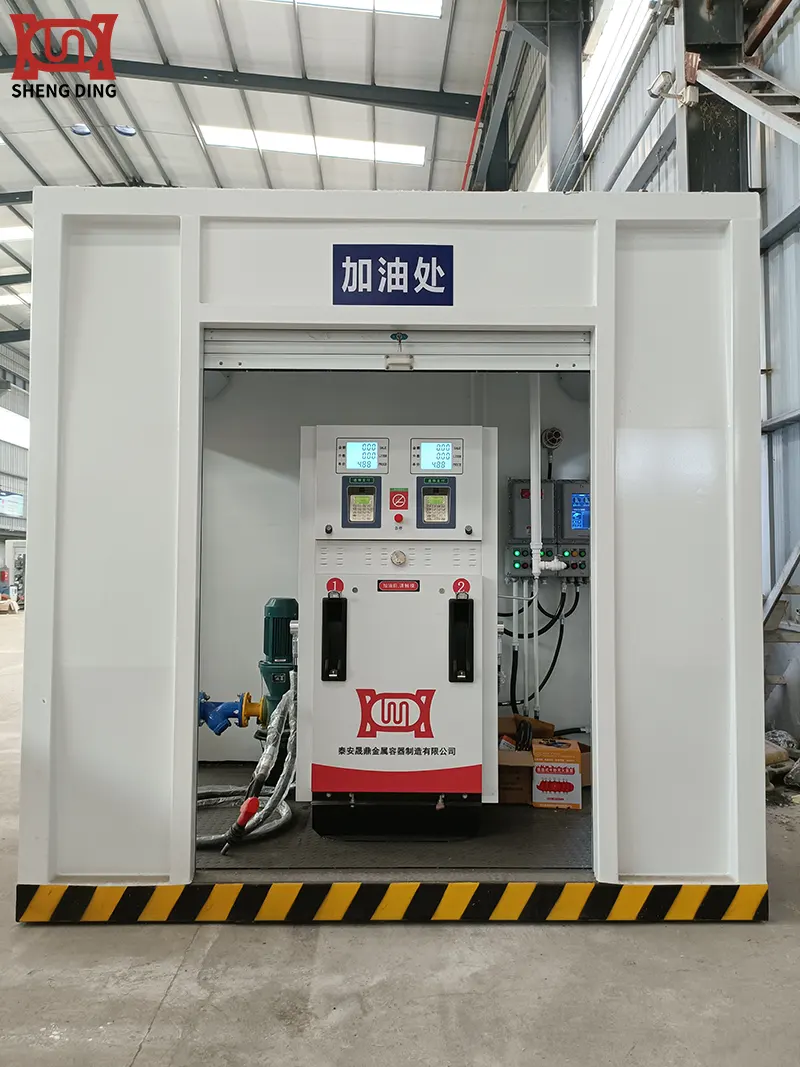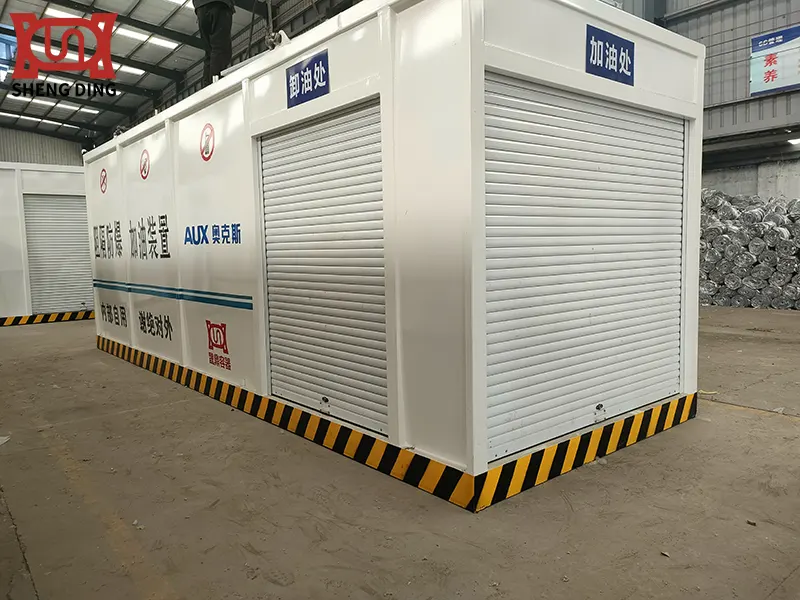Basic operating procedures and precautions for oil tank unloading at skid-mounted fuel station
Unloading oil at a skid-mounted fuel station is a high-risk operation that requires strict adherence to safety regulations and operating procedures to prevent fires, explosions, leaks, environmental pollution, and personal injury. The following are key steps and precautions for unloading oil at a skid-mounted fuel station:
Core Principles: Safety First, Prevention First, Standardized Operations.
I. Pre-Unloading Preparation
1. Personnel Preparation:
- Certifications: Operators must undergo professional training and pass assessments, and be familiar with the equipment, procedures, and emergency response plans.
- Clear Responsibilities: Designate a site supervisor, unloading operator, and supervisor, and clearly define their respective responsibilities. At least two people should be on-site at any one time.
- Personal Protection: Wear a full set of approved personal protective equipment (PPE), including:
- Anti-static work clothes and work shoes (nailed shoes are strictly prohibited).
- A hard hat.
- Oil-resistant protective gloves.
- Safety glasses or a face shield.
- Wear respiratory protection equipment when necessary (especially when handling oil and gas or when there is a risk of leaks).
- Eliminate Fire Sources: Fire sources (lighters, matches, etc.), cell phones, and other non-explosion-proof electronic devices are strictly prohibited from entering the unloading area and surrounding safety areas. Smoking is prohibited. Turn off the skid-mounted station's refueling function (if necessary).
2. Vehicle Inspection and Guidance:
- Guided Parking: Guide the tanker truck to a stable stop at the designated unloading location. Place wheel chocks (triangular wooden blocks) under the wheels, apply the parking brake, turn off the engine, and remove the key and hand it over to the on-site supervisor.
- Vehicle Inspection:
- Inspect the tanker truck for significant deformation, damage, or leaks.
- Inspect the vehicle's fireproof cover for integrity and effectiveness.
- Inspect the vehicle's static grounding device for integrity.
- Inspect the vehicle's exhaust flame arrester for integrity and effectiveness.
- Inspect the vehicle's safety markings for legibility.
- Verify Information: Verify that the tanker truck's license plate number, fuel name, brand, and quantity are consistent with the planned unloading documents.


3. Equipment and Site Preparation:
- Electrostatic Grounding:
- After the tanker truck has come to a complete stop, immediately connect an effective electrostatic grounding device (grounding clamp) to ensure a reliable ground connection. The connection point should be a clean, rust-free, and unpainted metal surface.
- Check and ensure the skid-mounted equipment's grounding connection is secure and reliable.
- Use an electrostatic grounding alarm to confirm that the grounding resistance meets the required level (typically <= 10 omega).
- Firefighting Equipment: Check and ensure that firefighting equipment (fire extinguishers, fire blankets, fire sand, etc.) is available, functioning, and immediately operational near the unloading area.
- Warning and Isolation: Set up cordoned-off areas or warning signs (such as "Unloading in Progress, Keep Out of the Way" or "No Smoking") to prohibit unauthorized personnel and vehicles from entering.
- Tool Preparation: Gather the necessary unloading tools: unloading hose (with quick-connect), vapor recovery hose (if equipped with a vapor recovery system), sampler, dipstick, explosion-proof wrench, leak-proof material, absorbent material (oil absorbent felt), rags, etc. Ensure that all tools are in good condition, clean, and free of oil contamination.
- Ensure smooth communication: Ensure smooth communication between on-site personnel and with the control room (if any).
- Inspecting the tanks:
- Measure the oil level (empty height or actual height) in the skid-mounted station tanks and calculate the remaining oil volume. Ensure there is sufficient empty space to receive the unloaded oil (typically, a safety margin of at least 10%-15% is required).
- Check that the tank's breather valve (flame arrester) is unobstructed and intact.
- Check that the tank's manhole cover, oil gauge, and other equipment are properly sealed.
- Check that the tank's level gauge (if any) is functioning properly.
- Connecting the vapor recovery system (if equipped):
- If both the skid-mounted fuel station and the tank truck are equipped with a vapor recovery system, first connect the vapor recovery hose and ensure that the connection is secure and sealed.
- Open the valve on the vapor recovery line.
4. Document Verification and Sampling:
- Inspecting the documents: Verify and sign the unloading documents (such as the delivery note, oil quality inspection form, etc.). Initial Oil Quality Inspection: Before unloading, it is usually necessary to take a sample from the bottom of the tanker (using a dedicated sampler) for a visual inspection (color, water impurities, odor, etc.) to confirm that there are no obvious abnormalities in the oil quality. If any questions arise, suspend unloading and report them.
II. Unloading Operations
1. Connecting the Unloading Hose:
- Securely connect one end of a clean, intact, and static-dissipative unloading hose to the unloading port of the tanker (ensure the sealing gasket is intact).
- Securely connect the other end of the hose to the unloading port of the skid-mounted storage tank (ensure the sealing gasket is intact). Before connecting, ensure that the unloading port valve is closed.
- Ensure that the hose bends naturally, without kinks, dead bends, or excessive stretching, to prevent the hose from rubbing against the ground.
2. Opening the Valve and Unloading:
- Reconfirmation: The site supervisor and operator reconfirm that:
- The static grounding is reliable and effective.
- The oil vapor recovery connection is correct (if equipped).
- Firefighting equipment is in place.
- Personal protective equipment is in place.
- The storage tank has sufficient capacity. The unloading hose is securely and correctly connected.
- Nonessential personnel have been cleared from the site.
- Opening sequence:
- Slowly open the unloading valve on the tanker (open slightly first, confirm there are no leaks, then fully open).
- Slowly open the unloading valve on the skid-mounted station tank (also open slightly first to confirm there are no leaks).
- Follow the principle of "open the tanker valve first, then the tank valve; close the tank valve first, then the tanker valve."
- Control flow rate: During initial unloading, the flow rate should be controlled (usually <=1 m/s) to reduce static electricity generation. Once the liquid level submerges the nozzle, the flow rate may be increased appropriately, but it must remain within a safe range (following equipment specifications).
- Full-time monitoring: The operator must be on-site and continuously monitor the entire unloading process. Leakage and dripping at hose connections, valves, flanges, etc. are strictly prohibited. Closely observe:
- Check for leaks or dripping at hose connections, valves, flanges, etc.
- Check for changes in the liquid level in the tanker and tank (if level monitoring is used).
- Check for a secure static grounding connection. Is the vapor recovery system functioning properly (if equipped)?
- Are there any unusual odors, smoke, or sounds at the site?
- Is the surrounding environment safe?
III. Post-Unloading Procedures
1. Closing Valves:
- When the tanker truck is empty (or the planned unloading volume has been reached):
- First, slowly close the unloading valve on the skid-mounted station tank.
- Then, slowly close the unloading valve on the tanker truck.
- Ensure the valves are tightly closed.
2. Draining the Hose:
- Drain any remaining oil from the unloading hose (usually by opening the drain valve on the hose or using a siphon to drain it back to the tanker truck or a dedicated container). Do not discharge residual oil directly onto the ground or into a sewer.
- Drain the vapor recovery hose (if equipped).
3. Removing and Grounding the Hose:
- Remove the vapor recovery hose (if equipped) and secure the caps on both ends.
- Remove the unloading hose and secure the caps on the tanker truck and tank unloading ports.
- Store the hose carefully to avoid contamination or damage. Finally, remove the static grounding wire.
4. Resting and Measuring:
- After unloading, the oil needs to rest in the tank for a period of time (usually no less than 15 minutes, depending on the oil type and regulatory requirements) to allow bubbles and static electricity to dissipate.
- After resting, metering operations can be performed:
- Measure the oil level in the tank (empty or actual) to calculate the actual amount of oil received.
- Compare the amount with the unloading receipt to confirm the correct quantity. If there is any discrepancy, follow the procedure.
- Record the measurement results.
5. Sampling (Final Inspection):
- Take samples from the tank (according to regulatory requirements) and send them for inspection or conduct necessary quality checks. Retain the samples (if required).
6. Site Cleanup:
- Remove any oil contamination and waste (such as rags, absorbent materials, etc.) that may have been generated during the unloading process and place them in designated containers for proper disposal.
- Recover tools and firefighting equipment.
- Remove cordons and warning signs.
7. Document Signing and Recording:
- Both parties (gas station and transporter) confirm the completion of oil unloading and sign relevant documents (such as an oil unloading confirmation).
- Complete detailed and accurate oil unloading operation records, including: date, time, oil name and brand, pre-unloading quantity, post-unloading quantity, operator, supervisor, vehicle information, equipment condition, and any abnormalities.


IV. Key Safety Considerations
- Anti-static electricity: Anti-static grounding is paramount! Ensure reliable and effective connections and maintain them throughout the unloading process. Disconnect only after draining the hoses. Control the initial flow rate.
- Prevent leaks: Inspect gaskets before connecting hoses; perform leak checks after connections and before opening valves; and closely monitor all connection points throughout the unloading process.
- Prevent fire and explosions: Strictly eliminate all ignition sources (fireworks, cell phones, non-explosion-proof electrical appliances, sparks, hot surfaces, etc.). Unloading operations are strictly prohibited during thunderstorms.
- Prevent oil mixups: Strictly verify the oil name and brand to ensure unloading into the correct tanks. When unloading different oil products, hoses and connectors must be thoroughly cleaned or dedicated lines must be used.
- Oil Spill Prevention: Accurately measure the empty tank volume before unloading to ensure sufficient space. Monitor the liquid level during unloading (if possible). The unloading port must have overflow prevention measures (such as an overflow valve).
- Personal Protection: Properly wear and use personal protective equipment (PPE). Avoid direct skin contact with oil products. Observe proper operating posture to prevent slips and sprains.
- Adequate Supervision: Operators must provide continuous supervision throughout the operation and must not leave their posts without permission.
- Emergency Response: All personnel must be familiar with the emergency plan and know how to report and initially handle emergencies such as leaks and fires (such as immediately closing valves, using fire extinguishers, initiating emergency shut-offs, and evacuating). Necessary emergency supplies must be available on site.
- Compliance with Regulations: Strictly adhere to national, local, and internal company safety regulations, standards, and operating procedures.
V. Personnel Qualifications and Training
All personnel involved in oil unloading operations must receive comprehensive safety training, including:
- The hazardous properties of oil (flammability, explosiveness, toxicity, etc.);
- Equipment structure and operating principles;
- Standardized unloading operating procedures (SOPs);
- Static hazards and control;
- Emergency response measures for leaks, fires, and oil spills;
- The use and maintenance of personal protective equipment;
- Relevant legal and regulatory requirements.
- Performing the training and obtaining a certificate are essential for employment, and regular refresher training is required.
Summary:
Oil unloading operations at skid-mounted fuel station require a high level of responsibility and strict adherence to procedures. Safety must be prioritized at every stage, ensuring thorough preparation, standardized connections, careful operation, adequate supervision, proper handling, and complete record-keeping. Any negligence or non-compliant operation could result in disastrous consequences.
Remain vigilant at all times and internalize and implement safety procedures.
Written by
TAIAN SHENGDING METAL CONTAINER MANUFACTURING CO., LTD.
Editor Wang
www.self-bunded-tank.com
WhatsApp:+86 152 5486 3111
Email:shengdingtank@126.com
- WhatsApp
- E-MailE-Mail:shengdingtank@126.com
- WeChatWeChat:15254863111









